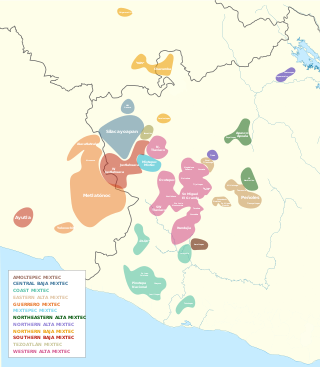Related Research Articles

Almoloya de Juárez is a town in the State of Mexico and the seat of the municipality of Almoloya de Juárez. The name Almoloya comes from the Nahuatl, that is properly Almoloyan, composed of: atl, "water"; molo "impersonal voice of moloni, to flow the source" and yan, "place"; that it means "place where flows the water source".

The Triqui or Trique are an Indigenous people of the western part of the Mexican state of Oaxaca, centered in the municipalities of Juxtlahuaca, Putla, and Tlaxiaco. They number around 23,000 according to Ethnologue surveys. The Triqui language is a Mixtecan language of Oto-Manguean genetic affiliation. Trique peoples are known for their distinctive woven huipiles, baskets, and morrales (handbags).
Putla Villa de Guerrero or simply Putla, is a town and municipality in the State of Oaxaca, Mexico. It is part of Putla District in the west of the Sierra Sur Region.
Temascal is a town in the Mexican state of Oaxaca which is the seat of the municipality of San Miguel Soyaltepec. It is part of the Tuxtepec District of the Papaloapan Region. The name Soyaltepec means "hill of palm trees" in Náhuatl but the area also carries the Mazatec name of Naxhingee which means “ragged hill”.
Santiago Jamiltepec is a town, and the seat of surrounding municipality of the same name, in the Mexican state of Oaxaca. It is located in the Jamiltepec District in the west of the Costa Chica Region, 30 km east of Pinotepa Nacional on Federal Highway 200, and 460 km southwest of state capital Oaxaca de Juárez.
San Juan Achiutla is a town and municipality in Oaxaca in south-western Mexico. The municipality covers an area of 49.76 km2. It is located in a mountain range, between the hills Negro to the East, Yucuquise to the Northwest, Cuate to the North and Totolote to the South. It is crossed by the river Los Sabinos and has a dam called Cahuayande. Its weather is temperate. It is in the Mixteca Alta, one of the three parties that make up the Mixteca region and in the Mixteca Alta is part of what was Achiutla, the significant Prehispanic place.
San Miguel Piedras is a town and municipality in Oaxaca in south-western Mexico. The municipality covers an area of 108.45 km². It is part of the Nochixtlán District in the southeast of the Mixteca Region.

The Cuenca del Papaloapan Region is in the north of the Mexican state of Oaxaca, where the foothills of the Sierra Madre de Oaxaca meet the coastal plain of Veracruz. The principal city is San Juan Bautista Tuxtepec, the second largest in the state of Oaxaca.

Nochixtlán District is located in the southeast of the Mixteca Region of the State of Oaxaca, Mexico. The main city is Asunción Nochixtlán.

The Indigenous people of Oaxaca are descendants of the inhabitants of what is now the state of Oaxaca, Mexico, who were present before the Spanish invasion. Several cultures flourished in the ancient region of Oaxaca from as far back as 2000 BC, of whom the Zapotecs and Mixtecs were perhaps the most advanced, with complex social organization and sophisticated arts.

The internal classification of Mixtec is controversial. Many varieties are mutually unintelligible and by that criterion separate languages. In the 16th century, Spanish authorities recognized half a dozen lenguas comprising the Mixtec lengua. It is not clear to what extent these were distinct languages at the time. Regardless, the colonial disintegration of the Mixtec nation and resulting isolation of local communities led to the rapid diversification of local dialects into distinct languages. Below are some attempts at Mixtec classification by various scholars.
Silacayoapan is one of the more extensive Mixtec languages. It is spoken by 150,000 people in Puebla and across the border in Guerrero, as well as by emigrants to the United States.
Atatláhuca–San Miguel Mixtec is a diverse Mixtec language of Oaxaca.
Cuyamecalco Mixtec is a Mixtec language of Oaxaca spoken in Cuyamecalco, San Miguel Santa Flor, and Santa Ana Cuauhtémoc. Egland & Bartholomew had found Cuauhtémoc to be more intelligible with Coatzospan Mixtec, which in any case is close to Cuyamecalco.
Chayuco-Jamiltepec Mixtec is a Mixtec language of Oaxaca, spoken in the towns of San Agustín Chayuco, Santa Catarina Mechoacán, Santiago Jamiltepec, San Andrés Huaxpaltepec, Santa María Huazolotitlán, Santiago Tetepec, and Santa Elena Comaltepec.
Tututepec Mixtec is a Mixtec language of Oaxaca, spoken in Santa María Acatepec, Santa Cruz Tututepec, San Pedro Tututepec and other towns. It is not close to other varieties of Mixtec.
Pinotepa Mixtec is a Mixtec language of southern Oaxaca. Ethnologue lists the variety of San Juan Colorado / San Pedro Atoyac as a separate language.
(Magdalena) Peñasco Mixtec, also known as Tlacotepec Mixtec, is a Mixtec language of Oaxaca spoken in the towns of Santa María Magdalena Peñasco, San Cristobal Amoltepec, San Mateo Peñasco, and San Agustín Tlacotepec. It has closer unidirectional intelligibility with other varieties, but may be closest to Ñumí Mixtec.
Chazumba Mixtec is a Mixtec language of Puebla and Oaxaca, spoken in the towns of Santiago Chazumba, San Pedro y San Pablo Tequixtepec, Zapotitlán, Santa Gertrudis Cosoltepec, Petlalcingo, and Totoltepec de Guerrero.
Southern Puebla Mixtec, denominated by INALI as Puebla-Oaxaca borderline Mixtec, and also known as Acatlán Mixtec, is a Mixtec language of Puebla and Oaxaca State in Mexico. It is spoken in the towns of Acatlán, Xayacatlán de Bravo, San Jerónimo Xayacatlán, Petlalcingo, and Zapotitlán Palmas.
References
- 1 2 San Miguel Piedras Mixtec at Ethnologue (18th ed., 2015) (subscription required)